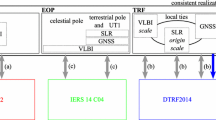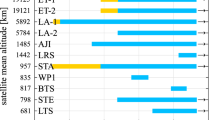Abstract
This article is devoted to determining Earth’s Orientation Parameters (EOP) from reprocessing of the Laser ranging observations of the specially designed satellites. These are laser geodynamics satellites Lageos and Etalon and Low Earth Orbiters Lares, Ajisai, Starlette, and Stella. New software was created by the author and a new approach was proposed to analyze each model of geodynamics phenomena; a transformation or process was first tested separately and only then included into the package. The main attention was paid to the analysis of the possibility to use Laser Ranging data to Low Earth Orbiters for EOP determination. It was shown that, despite the much lower Lares’s orbit (height is 700 km) than the Lageos’s orbit (7000 km), the resulting EOP series from Lares data have the same precision in general. It was achieved by new software and a new author approach to the study of the models. Final EOP data sets were computed at the same time by a combination of raw EOPs from each satellite or from the combination of the conditional equations. In the latter case, the precision of the final solution is 10–15% better. It allows us to recommend Low Earth orbiters for geodynamics on a permanent basis.


Similar content being viewed by others
REFERENCES
D. Bilitza, International Reference Ionosphere 1990, URSI/COSPAR, NSSDC/WDC-A-R&S 90-22.-1990 (National Space Science Data Center — World Data Center A for Rockets and Satellites, Greenbelt, Md., 1990). https://iri.gsfc.nasa.gov/docs/IRI1990pp0-84.pdf.
V. Ya. Choliy, “On the extension of Helmert transform,” Adv. Astron. Space Phys. 4, 15–19 (2014).
V. Choliy and V. Zhaborovsky, “KyivGeodynamics++: Software for processing satellite laser ranging data,” Adv. Astron. Space Phys. 1, 96–98 (2011).
V. Ya. Choliy and V. P. Zhaborovsky, “Earth’s pole coordinates determined from Lageos-1/2 laser ranging,” Adv. Astron. Space Phys. 4, 54–57 (2014).
IERS Conventions (2010), Ed. by G. Petit, and B. Luzum, IERS Technical Note No. 36 (Bundesamt für Kartographie und Geodäsie, Frankfurt am Main, 2010).
J. Picone, A. Hedin, D. Drob, et al., “NRLMSISE-00 empirical model of the atmosphere: Statistical comparisons and scientific issues,” J. Geophys. Res.: Space Phys. 107, SIA 15-1–SIA 15-16 (2002). https://doi.org/10.1029/2002JA009430
Author information
Authors and Affiliations
Corresponding author
About this article
Cite this article
Choliy, V.Y. Pole Coordinates and Length of Day from Laser Ranging of Low Earth Orbiters. Kinemat. Phys. Celest. Bodies 37, 263–268 (2021). https://doi.org/10.3103/S0884591321050068
Received:
Revised:
Accepted:
Published:
Issue Date:
DOI: https://doi.org/10.3103/S0884591321050068




